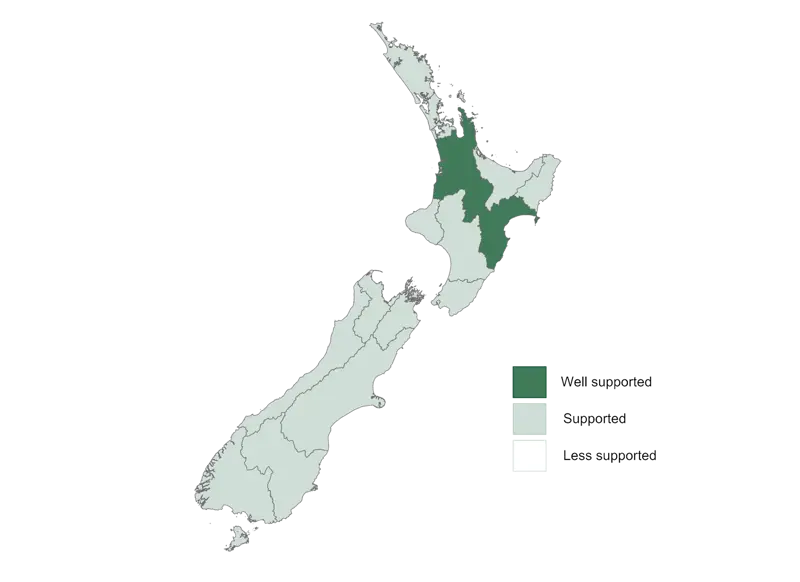
Land Use Fact Sheet
Blueberries — covered cropping
Blueberries have traditionally been grown outside in free draining soils, but the move to growing under cover has tremendous growth opportunities.
Low tech tunnel houses let work continue regardless of the weather. Fruit is kept dry and picked rain or shine. Spraying is easier and you don't need as much chemical as there's little or no spray drift. Pests and diseases can be controlled more effectively. Water and nutrition can be managed to provide the highest yield and the best quality fruit, improving returns for the landowner.
 Overview
Overview
Regions
Blueberries can be grown under cover all over New Zealand, but most operations are in the Waikato and Hawke's Bay.
Growing conditions
Covered blueberries are usually planted in a substrate, such as coconut fibre. This allows control over water and nutrients.
Climate
Covered crops can be grown in any climate, if the buildings are safe from damage caused by extreme weather events.
Commercial scale
1 ha of flat land under cover, plus space for infrastructure like driveways, pumps and supplemental buildings.
Getting started
Building the infrastructure for covered crops is expensive, but it allows you to achieve excellent returns on a small block.
Skills / employment
Covered cropping provides a steady amount of work year-round, which makes it easier to secure and keep workers.
 Regions
Regions
Most blueberries are grown in the Waikato and Hawke's Bay, but blueberries can be grown anywhere in New Zealand under cover. There are new developments currently underway in the Far North and Southland.
Get a report on your whenua
Enter the details of your whenua into our search to create a downloadable report showing information about the environment, economy, and climate in your region — and the potential that creates for development.

 Commercial scale
Commercial scale
1 hectare of flat land under cover, plus space for infrastructure such as driveways, bore and pumping systems and supplemental buildings.
 Getting into the industry
Getting into the industry
The cost of building the infrastructure for a covered crop can seem daunting, but as an intensive growing method you can reach commercial scale with a relatively small block as well as achieving excellent returns.
There are a wide range of options when it comes to the design of your operation. It's important to get advice from an experienced consultant before making decisions about details like row width, plant spacing, substrate and irrigation.
The starting point for lower-tech tunnel houses for blueberries is at least 10,000 sqm (1 hectare) of flat land plus space for infrastructure such as driveways, bore and pumping systems and supplemental buildings. The build costs for the structure itself can start in the $400,000 to $500,000 range. It's important to get professional, experienced advice when designing and building your structure.
The first small harvest will be 1 year after planting. Full production is achieved by year 3 or 4. Upfront capital costs are high but a well-run operation should return an annual net profit by year 5. Years 6 to 10 deliver the largest financial gains.
Growers typically sell direct to a wholesaler, who will then onsell to domestic retailers or the export market.
Industry organisation Blueberries New Zealand will help member growers to connect with domestic and export markets. Membership is voluntary. There is a registration fee for new members, with the annual membership fee calculated as a levy on fruit sold.
 Skills and employment
Skills and employment
Greenhouse operations, like most horticulture outdoor growing operations, have peak seasons which require additional labour. The peak season for blueberry picking is November to March.
Typical day-to-day tasks when working with a covered crop include:
- planting
- plant maintenance such as pruning
- harvesting
- mixing and handling fertiliser and sprays, and
- pest and disease identification and management.
 Compliance
Compliance
New Zealand Good Agricultural Practice (NZGAP) provides assurance for the safe and sustainable production of fruit and vegetables grown in New Zealand. This food safety programme is recognised by wholesalers and retailers.
NZGAP is not compulsory for independent operators selling domestically but it is required for export and preferred by domestic wholesalers. It helps growers with all the overheads of keeping up with the wide range of compliance requirements. Becoming NZGAP certified gives you confidence that you are compliant with food safety and other regulations. It makes it easier to find out when regulations have changed, and it makes your product more attractive to buyers.
If you are not NZGAP accredited you must still meet the requirements of National Programme 1 under the Food Act 2014 to ensure that the blueberries you are supplying to the market are safe to eat. This includes rules about how the crop is handled, managing spray residue and withholding periods.
Levies
There are no compulsory levies for blueberry growers.
You can choose to join the industry organisation Blueberries New Zealand, who provide a wide range of support and resources for members. Membership is paid in an initial registration fee followed by an annual levy calculated on fruit sold.
Licencing
Some varieties of blueberry have licencing costs or require royalty payments when the plants are purchased. Speak to your commercial nursery for advice.
Permits and consents
Check with your local council to ensure you are meeting all permit and consent obligations. You may need permits for the tunnel house or greenhouse structure. You may also need a water consent which may require the assistance of a hydrologist to put together your application.
In some areas, access to irrigation water is becoming challenging.
National policy statement for freshwater management (NPSFM)
The National Policy Statement for Freshwater 2020 gives local authorities direction on how they should manage freshwater under the Resource Management Act 1991. As such, some local authorities require growers and farmers to create a Farm Environment Plan (FEP). Make sure you're familiar with the FEP expectations in your region. Check with your local council about the requirements for your whenua or planned development.
Even if your region doesn't yet require an FEP, it's good practice to put one in place for your whenua as part of your business plan. The Foundation for Arable Research (FAR) provides templates you can use to create an FEP.
 Growing conditions
Growing conditions
Blueberries can be planted in soil or in pots or bags in a substrate, such as coconut fibre. Fibre substrate gives you complete control over the irrigation and water content, which leads to better quality and better yields. It also allows you to grow on any soil type, as long as the land can support the tunnel house structure. You would allow for 28-30 litres of substrate per plant.
Blueberries require no added heat in New Zealand conditions but they produce faster with additional heating and lighting.
Planting density depends on the variety of blueberry. An intensive operation can have up to 2 plants per square metre with the width between rows at around 1.8 to 2.2 metres wide. At this density the substrate pots are touching each other down the length of each row.
As with all berries, pest and disease require constant management and control. Biological controls such as predator mites and pheromone traps are more effective in a covered crop than they are in outdoor cultivation. If fruit is being damaged by birds then bird nets may be added to prevent birds entering the structures.
 Climate
Climate
Blueberries do not require additional heating as they naturally survive at very cool temperatures, however extra heat speeds up ripening so you can deliver product to market faster.
Blueberries can be planted under cover anywhere in the country. New major develops are currently underway in both the Far North and Southland.
Speak to a commercial nursery to get a better understanding of the best cultivars and heating requirements for your location and operation.
 Water
Water
Blueberries are sensitive to sodium chloride. Have your water source tested and take professional advice on the outcome before you consider growing blueberries.
Covered cropping using substrate, rather than growing plants in the ground, is a hydroponic operation. This means that all of the plant's nutrients are provided in the water (adding nutrients directly to the water is called fertigation). Water is controlled so that each plant gets exactly what it needs to grow and produce the highest yield and quality of berries.
This method of growing requires access to a lot of water. Plan to provide 100 litres per square meter per month during summer, and around 10 litres over the cold months of winter.
Speak to a qualified, experienced consultant to make sure your water requirements have been properly scoped for your operation.
 Market
Market
Estimates of the amount of blueberries in New Zealand range from 400 to 620 hectares of land area currently planted or being planted. This is changing rapidly with new covered operations opening in Northland and Southland and expansions underway in other areas.
The export value of blueberries has doubled since 2010 to $41 million in 2016, spurred by research and recognition of their health benefits.
Industry organisation Blueberries New Zealand provides support and resources to growers.
 Future industry
Future industry
Currently, most of New Zealand's blueberry crop is grown outside, usually with no cover other than bird protection. This is rapidly changing. Tunnel houses have begun to transform the industry, with large scale covered operations being built around the country.
New varieties and growing techniques are shifting the industry from one plant per square metre to two plants per square metre.
The industry expects that the move towards covered cropping and intensification will see large improvements in yields that will support continued growth in the market.
Understanding the right varieties to plant for your situation is key.
 Operational costs
Operational costs
Operational costs for a covered growing system are more wide-ranging than for typical outdoor cultivation. You need to allow for fertigation costs, equipment maintenance and overheads like electricity and fuel as well as other annual operational costs.
An operational low-spec tunnel house may have running costs of between $210,000 to $270,000 per hectare per year, depending on scheduled maintenance and other factors.
It's important to get qualified, experienced advice on the set up and administration of your operation as well as preparation of your annual budget.
 Grower returns
Grower returns
For a standard density operation with one plant per square metre, a grower would expect to achieve 4.5 kg per plant by year 4 (where Year 1 is when the plants went in).
In 2018 the average gross price to the grower was $15 per kg for quality fruit and $5 per kg for fruit that was sold for processing, with about 80% of the crop achieving the higher price.
 Seek advice
Seek advice
Seek advice early, before you invest in any design or development.
Talk to your local Te Puni Kōkiri office to see how they can support you through your decision-making process. They will be able to provide advice and find out whether your project qualifies for funding.
Talk to the industry organisation to see what support and resources they can offer to people thinking about growing blueberries.
If possible, seek out advice from people who grow blueberries in your area as well as knowledgeable suppliers.
Talk to qualified consultants who are experienced in blueberry growing and other land developments in your area. They will be able to provide detailed, impartial advice on what will (and won't) work on your whenua.
 About this fact sheet
About this fact sheet
This fact sheet provides general information to help start and inform conversations. It is not comprehensive enough to support detailed decision-making.
The information in this fact sheet has been contributed by Grower2Grower, Blueberries New Zealand and Te Puni Kōkiri kaimahi. Data that has not been credited in the body of the fact sheet has been provided by the contributors.
You can provide feedback on the content on this or any fact sheet by emailing us at TPKinfo@tpk.govt.nz